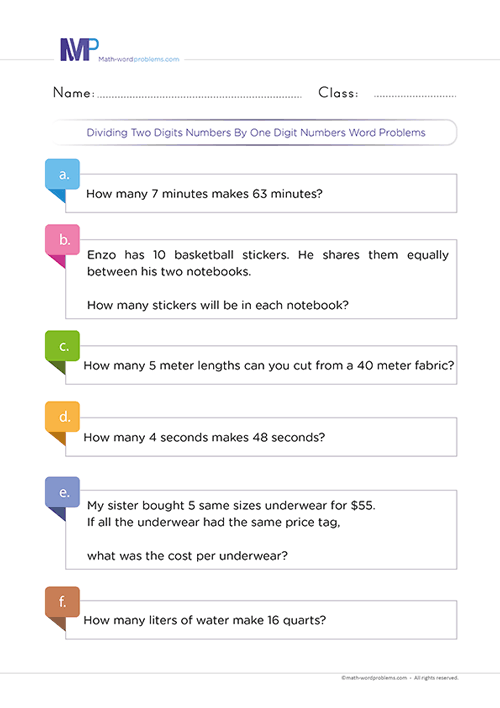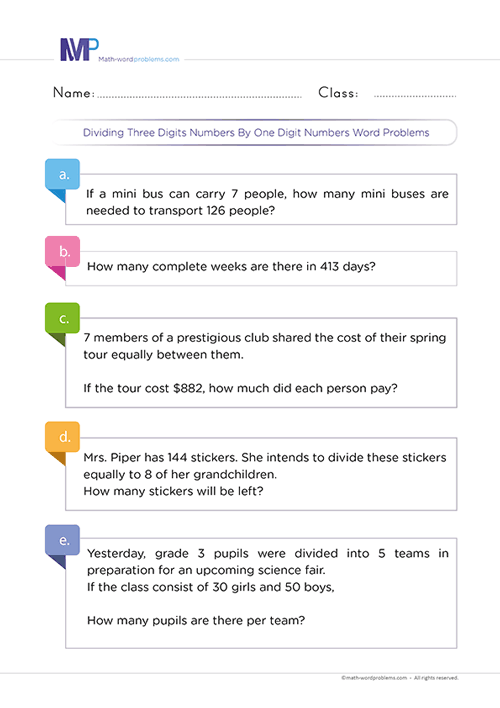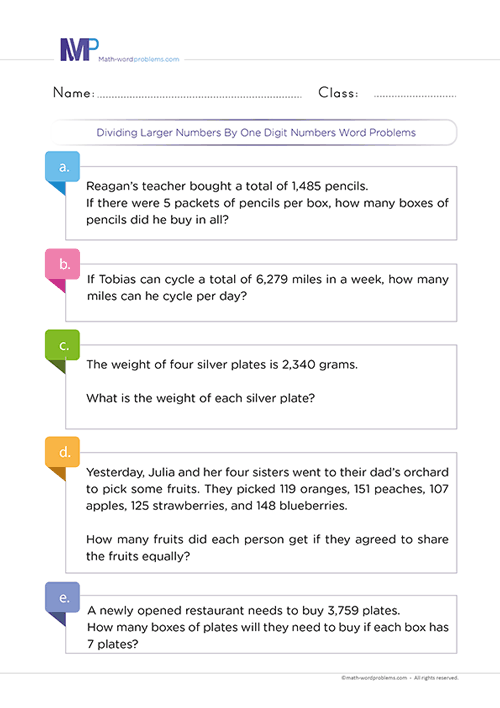 How to divide two -digits numbers by one-digit number word problems
How to divide two -digits numbers by one-digit number word problems

- INTRODUCTION
- Step 1 Identify
- Step 2 STRATEGIZE
- Step 3 SET UP
- Step 4 PROVIDE A SOLUTION
- Step 5 CHECK YOUR WORK
Get more contents on this skill...
Your kids will learn how to divide two-digit numbers by one-digit number word problems most effectively after engaging in this remarkable resource.
This guide also aims to sort out the many factors hindering kids' division learning abilities, such as negative mindsets, less effective coaching, not reading to understand, less active involvement, and undiagnostic confusion.
Above all, your 3rd Graders will find this resource enjoyable as we provide them with short and straightforward strategies how to divide two-digit numbers by one-digit number word problems. for dividing two-digit numbers by one-digit number word problems
Steps on how to perform the division of two- digits numbers by one-digit number word problems
Below are simple steps on how to perform the division of two-digit numbers by one-digit number word problems.
These captivating steps will attract your interest and attention, even if you are a tutor, parent, or learner. However, we will include enriching, fun examples and steps of dividing two-digit numbers by one-digit number word problems. Thus, an inspirational way to solve more complex division word problems.
Step 1 IDENTIFY THE PROBLEM
To identify the problem,
- You can start by reading out the problem carefully to understand it.
- Then, identify and underline vital statements that are related.
- Now, reread the problem and try to figure out any important numbers and keywords in the problem.
That is, the keywords that you’ll most likely encounter when you need to perform a division operation are: - divide, half, evenly, every, per, parts, out of, the quotient of, the ratio of, how many in each, equal parts, cut up, average, as much, etc.
Note: learners should understand that it would be best not to rely entirely on keywords alone because a particular keyword can have different meanings in different word problems.
In that case, you need to read the question very well to understand the situation the word problem describes. After reading, you will also find out if the problem makes sense first before determining which operation you need to use.
Step 2 STRATEGIZE AND DETERMINE THE OPERATIONS
In this step, ask yourself this pertinent question because it helps, “how am I going to handle this problem?”
Here, you must apply the read-to-understand rule. That is to say, you have to read the word problem and try to interpret it in your own words.
Furthermore, since each word problem may require a different solving format, the key points below will enable you to tackle any word problem irrespective of the format.
- First, the keyword(s) in the word problem will help clarify the operation you need to carry out.
- However, relying on keywords alone to solve word problems has some limits, as mentioned in step 1 above.
- So, you must first read the word problem to understand the situation that the problem is describing.
- Reading the problem to understand it will enable you to identify the problem type and relative statements in the word problem, which, together with the keyword(s) in the problem, will determine the correct maths operation you need to use.
Step 3 SET UP A NUMBER SENTENCE AND AN EQUATION
- Now, after knowing which operation you will perform from step 2 above, construct short sentences to represent the information given in the word problem.
- These short sentences will represent the vital information that makes it easier to solve the word problem. In order words, it is like a diagram of the word problem.
- After that, you can now deduce a solvable maths equation to represent the information given in the sentences that you constructed above.
Step 4 SOLVE THE PROBLEM
After writing down the maths equation, divide the values using either the short or the long division method. Also, include the unit of measurement in your final answer.
Step 5 VERIFY YOUR ANSWER
Finally, check your work to make sure that your answer is correct. For instance, since you are dealing with only numbers and not algebraic expressions, it is good to use reasonableness by estimation to see if your answer makes sense.
Therefore, if you estimate and the answer is close to what you have, your answer is correct. However, if your answer is beyond reasonable limits, you must go back to step one and start again.
Examples of how to divide two-digit numbers by one-digit numbers word problems
Example One
Step 1:Read the problem and underline all the relational statements. The important numbers you will find after reading the word problem are 72 and 6. Also, the keyword in the word problem is “each.”
Step 2:The question is, how will you solve this problem?
Reread the problem and interpret it in your own words to come out with the correct operation without necessarily depending on the keyword.
The problem is saying that I have a certain number of eggs that I need to arrange into boxes that can hold a certain maximum number of eggs.
Now, the problem needs you to calculate the number of boxes I need.
Now, “which operation can I use to split a large group/part into smaller groups/parts such that every group/part will have an equal number of things?”
For example, in the given problem, the large group you need to split is the number of eggs, and the number of items needed in every group is the number of eggs a box can hold.
So, from the situation that the problem is describing, from interpreting the problem in your own words, and from the keyword found in the word problem, it shows that you have to perform a division operation.
Step 3:Construct short sentences representing the most vital information in the word problem.
After that, translate the sentence that is in bold below into an accurate solvable math equation.
- Number of eggs that I have = 72
- Number of eggs that a box can hold = 6
- Therefore, the number of boxes that I need = the number of eggs I have ÷ the number of eggs a box can hold.
→ 72 ÷ 6 = ?
Step 4: From step 3 above, divide the values using either the short or the long-division method. Also, include the unit of measurement in your final answer.
Using the long-division method, we have
So, I will need 12 boxes
Step 5:Finally, check your work to ensure your answer is correct. Since you are dealing with only numbers and not algebraic expressions, it is good to use reasonableness by estimation to see if your answer makes sense.
So, if you estimate and the answer is close to the one you have, then your answer is correct. However, if your answer is beyond reasonable limits, you must go back to step one and start again.
Example Two
Step 1: Read the problem and underline all the relational statements. So, the important number after reading the word problem is 84. Also, there is no explicit keyword in the word.
So, what do you do now?
Step 2: The question is, how will you solve this problem?
Reread the problem and interpret it in your own words to come out with the correct operation without necessarily depending on the keyword.
The problem is asking for the number of weeks in 84 days.
So, So, this is what should come into your mind. “How many days are there per week?”
When you get the answer to this question, you now proceed to the next question
So, “which operation can I use to split a large group/part into smaller groups/parts such that every group/part will have an equal number of things?”
Back to the given question, the large group you need to split is the number of days, and the number of items needed in every group is the number of days per week.
You see that, from the situation that the problem is describing and from interpreting it in your own words, it shows that you have to perform a division operation.
Step 3: Construct short sentences representing the most vital information in the word problem.
After that, translate the sentence that is in bold below into an accurate solvable math equation.
- Number of days given = 84
- Number of days per week = 7
- Therefore, the number of weeks in 84 days = the number of days given ÷ the number of days per week
→ 84 ÷ 7 = ?
Step 4: From step 3 above, divide the values using either the short or the long-division method. Also, include the unit of measurement in your final answer.
Using the long-division method, we have
So, there are 12 weeks in 84 days
Step 5: Finally, check your work to ensure your answer is correct. Since you are dealing with only numbers and not algebraic expressions, it is good to use reasonableness by estimation to see if your answer makes sense.
So, if you estimate and the answer is close to the one you have, then your answer is correct. However, if your answer is beyond reasonable limits, you must go back to step one and start again.





